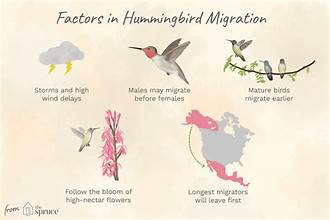
When Do Hummingbirds Leave? As Migration Starts, How to Spot the Flitting Fliers
As summer draws to a close, nature enthusiasts and birdwatchers eagerly anticipate the annual migration of hummingbirds. These tiny, vibrant birds, known for their rapid wingbeats and dazzling colors, embark on a long journey southward to escape the colder months. But when exactly do hummingbirds leave, and how can you best observe them as they prepare for migration? This guide will provide insights into the timing of their departure, tips on spotting them, and ways to support them during this critical time.
Understanding Hummingbird Migration
This bird migration is a remarkable natural phenomenon that sees these diminutive birds travel thousands of miles from their breeding grounds in North America to their wintering sites in Central America and Mexico. The journey is driven by the changing seasons and the availability of food sources. As days grow shorter and temperatures drop, hummingbirds begin their southward trek in search of warmer climates and abundant nectar.
The timing of migration varies depending on the species and their geographic location. In general, most hummingbirds start migrating in late summer or early fall. Ruby-throated hummingbirds, the most common species in the eastern United States, typically begin their journey in August and continue through September. Meanwhile, species like the Rufous hummingbird, which breeds further north in Alaska and Canada, may start their migration as early as July.
When Do Hummingbirds Leave?
The exact timing of when hummingbirds leave depends on several factors, including the specific species, weather conditions, and the availability of food. In general, the migration process starts gradually, with some hummingbirds beginning to depart as early as late July, while others may linger into October.
- Ruby-throated Hummingbirds: In the eastern United States, Ruby-throated hummingbirds are among the first to leave. Males typically migrate earlier, often in late July or early August, while females and juveniles follow a few weeks later. By mid-September, most of these hummingbirds have left their breeding grounds.
- Rufous Hummingbirds: Rufous hummingbirds, known for their extensive migratory range, begin their journey from the Pacific Northwest, Alaska, and Canada in late July or early August. They are among the earliest migratory hummingbirds and may pass through the western United States well into September.
Spotting Hummingbirds During Migration
While hummingbirds may be preparing to leave, migration is an excellent time to observe these agile fliers. As they gather energy for their long journey, hummingbirds become more active and can be seen frequenting feeders, flowers, and natural habitats. Here are some tips to help you spot hummingbirds during this exciting time:
- Keep Feeders Filled: Hummingbirds need to build up fat reserves before migrating, so providing a steady supply of nectar can attract them to your yard. Ensure your feeders are clean and filled with a solution of four parts water to one part white sugar. Avoid using red dye or artificial sweeteners, as these can be harmful to the birds.
- Plant Nectar-Rich Flowers: If you have a garden, planting flowers that produce abundant nectar can attract hummingbirds. Some of their favorites include trumpet vine, bee balm, salvia, and columbine. These plants not only provide a natural food source but also create a vibrant and inviting environment for hummingbirds.
- Look for High-Activity Areas: During migration, hummingbirds are often found in areas with high concentrations of flowers and feeders. Gardens, parks, and natural reserves with blooming plants are ideal spots for birdwatching. Early morning and late afternoon are prime times to see them feeding.
- Observe Migratory Routes: If you live along a known migratory route, you may have more opportunities to see hummingbirds as they pass through. The Gulf Coast, the Mississippi Flyway, and the Rocky Mountains are all major migration corridors for various species of hummingbirds.
- Listen for Their Calls: Hummingbirds are not just visual wonders; they also produce distinctive calls and chirps. While their high-pitched sounds can be difficult to hear, paying attention to these vocalizations can help you locate them in dense foliage or as they zip between flowers.
Supporting Hummingbirds During Migration
Migration is a challenging and energy-intensive process for hummingbirds. You can play a role in supporting them by providing food, shelter, and a safe environment. Here are some ways to help:
- Extend Feeding Season: Keep your feeders up until at least two weeks after you’ve seen your last hummingbird. Some late migrants may rely on these food sources as they make their way south.
- Provide Water Sources: Hummingbirds need water for both drinking and bathing. Consider setting up a shallow birdbath or a misting device to create a water source that’s easily accessible to them.
- Create a Safe Environment: Keep your yard free of pesticides and chemicals, as these can contaminate the nectar and harm hummingbirds. Additionally, consider placing your feeders away from windows to reduce the risk of collisions.
- Offer Resting Spots: Hummingbirds need to rest and conserve energy during migration. Providing perches, such as small tree branches or trellises, can give them a place to take a break.
- Document and Share Observations: Citizen science projects like Journey North and eBird encourage people to record their hummingbird sightings during migration. Participating in these initiatives can help researchers track migration patterns and contribute to conservation efforts.
Conclusion: The Magic of Hummingbird Migration
This birds migration is one of nature’s most awe-inspiring events, offering birdwatchers a unique opportunity to witness these tiny creatures embark on a journey that spans thousands of miles. By understanding when hummingbirds leave, learning how to spot them, and taking steps to support them, you can fully appreciate the magic of their migration. As these flitting fliers prepare for their long trek, every moment spent observing them becomes a reminder of the incredible resilience and beauty of the natural world.







